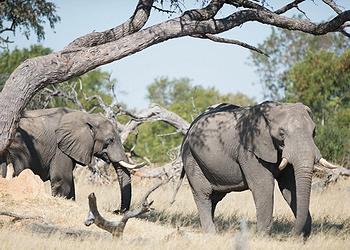
By Adam Cruise
HWANGE NATIONAL PARK, Zimbabwe, June 26, 2017 (ENS) – More than 14 elephants, including a mother and her young calf, have been poisoned in and around Zimbabwe’s premier game reserve, Hwange National Park. Most of the poisoned elephants died near the south of the park. Some had their tusks hacked off. The others were found outside the northern sector of the park in state forestry land.
Colin Gillies, vice-chairman of the Matabeleland branch of Wildlife and Environment Zimbabwe, an organization that conducts annual elephant counts in Hwange, says the lush vegetation from good seasonal rains has been hampering the search.

The use of poison has become the increasing modus operandi for poachers targeting elephants for their tusks. Since 2013, this appalling method of poaching has killed hundreds of elephants throughout Zimbabwe.
And it’s not just elephants that are dying. Predators and scavengers such lions, hyenas, jackals and vultures endure a slow and agonizing death after eating the stomachs and intestines of the dead elephants. Other animals like antelope and zebra have succumbed after drinking the poison from contaminated buckets or poison-laced waterholes and salt licks.
The poachers use a dilute sodium cyanide solution and, in some cases, paraquat, a powerful agricultural herbicide that is extremely toxic to humans and animals.
Both cyanide and paraquat are readily available in Zimbabwe. Paraquat, although banned in the European Union, is used by farmers in Zimbabwe to kill weeds and grasses. The cyanide-based solution is common with Zimbabwe’s hundreds of thousands of informal miners, to dissolve and separate gold or silver from ore.
These poisons lately have become the preferred method of poachers, a silent means of killing large mammals that avoids the sound of rifle shots, which alert rangers to the whereabouts of poachers.
Gillies says, “Almost all the poisoned elephant carcasses in Hwange National Park have generally been discovered along the remote southern and north-eastern border of the National Park.”

He explains that these areas are far from the main tourist camps and are notoriously difficult for rangers to patrol effectively.
“The few crude vehicle tracks there,” he says, “are difficult to negotiate at the best of times, but they become completely inaccessible during the wet season.”
This unfenced section of the park borders the isolated and impoverished rural lands of the Tsholotsho District.
The tribal lands are situated on the eastern edge of the Kalahari Desert and lie atop the dry and porous infertile Kalahari sand, so even though small-scale farming is the sole means of economy here, the soil is insufficient for any commercial cultivation.
Dams and waterholes contain water only after heavy rains, and even then the water lasts only for a short time. Drought is a regular feature among these hard-pressed communities, who must also contend with national coffers that are just as dried out.
It’s therefore unsurprising that many villagers turn to the relatively profitable and easier prospect of poaching wild animals. A successful ivory poacher here would be able sell a single tusk for around R4000 (US$11), a small fortune for any farmer in this arid region.
The Zimbabwean National Parks and Wildlife Management Authority have responded to the problem with force. Park rangers have been given a clear shoot-to-kill policy from the Zimbabwean government for any poachers they find within a national park.
Those caught alive are given an automatic jail sentence of nine years, if found with ivory or poison.
“Magistrates in Zimbabwe are willing to enforce this heavy sentence,” says Trevor Lane, co-founder of the Bhejane Trust, a non-profit organisation that monitors poaching activities in Hwange, “as a result there is a high rate of successful convictions.”
In this last incident, National Park rangers responded rapidly. A bucket of poison was discovered and three arrests were made over the weekend. One of those arrested was found in possession of ivory.
It is hoped this assertive approach will be an effective deterrent against this sort of poaching, but for now the value of ivory and the desperation of poverty for many rural Zimbabweans seems to being outweighing the risks.
With an estimated population of nearly 83,000 elephants, Zimbabwe is one of the key elephant range states and home to the second largest estimated elephant population after Botswana.
African elephants are listed as Vulnerable on the IUCN Red List, the authoritative list maintained by the International Union for the Conservation of Nature.
They are considered as Endangered by the Convention on International Trade in Endangered Species, CITES. Most African elephants are listed on CITES Appendix I, which bans trade, apart from the populations of Botswana, Namibia, South Africa and Zimbabwe that are listed under CITES Appendix II, which allows limited trade.
In Zimbabwe, African elephants are not included on the government list of “Specially Protected Animals” because their population is so large. However, they are listed on the “Schedule of Animals with High Economic Value.”
See the detailed Zimbabwe National Elephant Management Plan 2015-2020 here.
{Co-published with Conservation Action Trust}
Copyright Environment News Service (ENS) 2017. All rights reserved.
